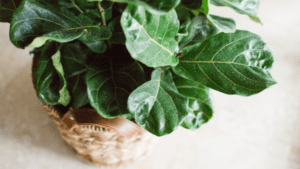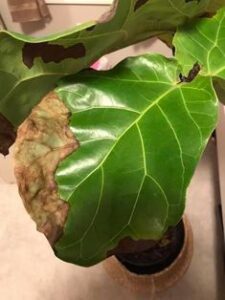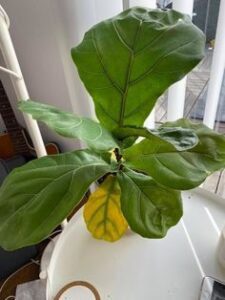Fiddle leaf plants are well known for their huge showy leaves big structure and ornamental fruits. This bold and beautiful plant adds up to the indoor aesthetic sense of a house. Fiddle leaf fig plant whose scientific name is Ficus lyrata belongs to the family Moraceae also known as Fiddle-leaf, Banjo Fig, and Lyre-leaf Figtree. Another member of the Moraceae family plant is Ficus alii. If conditions are favorable then of course this plant is easy to grow and maintain but yes this plant needs good care, dedication, and lots of respect to maintain its beauty. Hence the following article is all about the plants and how to deal with the brown spot on fiddle leaf and other issues.
Botanical description

The plant is irregular in shape and can attain a maximum height of 3-12 m with a spread of 9 m. But as a house plant, this plant can not exceed 2-3 m. For bushy full rounded look trimming of the plant is encouraged.
Leaves
The leaves of this plant are evergreen and large in shape smooth and glossy or leathery in appearance with raised or sunken veins and thick in structure.
Trunk
Woody, scaly with greyish shallowly-cracked bark
Flowers
Cream or off-white and are unisexual and monoecious.
Fruits
The fruits of Ficus plants are green and fleshy in appearance and are 2-3 cm in diameter.
Why this plant is called the Fiddle leaf plant or Lyre-leaf Figtree?
The dark and glossy green leaf of this plant looks like a lyre or violin (fiddle). hence also called a Fiddle leaf plant or Lyre-leaf Figtree.
How to take care of fiddle leaf plant
Light
The plant needs bright indirect light. the plant can tolerate an hour or 2 of direct sun from the east-facing sun but too much direct sun is not good for the fiddle leaf plant. Also too much shade or low light is not good for the plant to grow properly. It may result in slow growth and maybe leaf fall.
Water
Consistent water is required for fiddle leaf plants and the soil should be moist all the time not too much but yes little moist on top.
Temperature
day temperature is 70-80°F and during night it should be 10 degrees lower.
Humidity
Being tropical in origin in the central part of West Africa this plant needs good humidity. make sure to mist twice a week or set a humidifier in the room where you are going to keep this plant. Another way to maintain the humidity is to keep the plant on a pebble tray filled with water.
Soil
Regular potting and well-draining soil are good for the growth of the Fiddle leaf plant. It will be better if the soil incorporates organic fertilizers, mycorrhizal fungi, and other beneficial microbes.
Fertilizers
Fertilize once in four months or only during the spring or summer season. Stop feeding the plant during fall and winter.
Potting
Annual repotting is advisable for the plant Fiddle leaf. Shift the plant to a container at least 4 inches larger than the current pot. use heavy pots preferentially ceramic ones to avoid the toppling of the plant.
To know more about how to care for the fiddle leaf plant please read article “Care for Fiddle leaf fig (Ficus lyrata) and health benefits”
Common problems with fiddle leaf and how to deal?
Brown spot on fiddle leaf
A brown spot on the fiddle leaf may happen due to the following reasons
1. Excessive watering
Although the plant fiddle leaf needs humidity and regular watering excessive watering is always harmful to the plant. Frequent watering may result in root rotting. Brown spots along the yellowing of leaves are the crucial sign of over-watering of the plant and also a poor drainage system. Hence it is very important to check the drainage system of the pot and water when the topsoil dries up.
2. Infection
Another reason for the brown spot on the fiddle leaf may be a bacterial or fungal infection. hence it is very difficult to differentiate the reason why the spots are appearing on the leaf the better remedy is to remove the infected leaves and consider repotting if it appears again.
3. Sunburn

The plant fiddle fig needs bright indirect sunlight. Direct sunlight specifically the light from the south-facing positions may result in leaf scrotching. hot sunlight cooks the leaves and kills the cells thus resulting in the brown patch. The main solution to this problem is to simply move the plant to a shadier location. Filter the light or soften the light by installing sheer curtains or Venetian blinds. Do not move the plant suddenly to a higher light position try to acclimate the plant before moving.
4. Excess fertilizers
Fiddle leaf plants need fertilizers only during the spring or summer season. Overfertilizer or feeding during the winter season when the plant is not in its growing stage may result in the accumulation of chemicals that can interfere with the photosynthesis process by disrupting the chlorophyll cells. hence avoid too much feeding to the fiddle leaf fig plant.
5. Infestation
sometimes small spots on the leaves of the fiddle leaf are due to the infestation of pests like aphids, spider mites, scale, and mealybugs. Use a dilute soapy solution clean the leaf with the wet tissues and try to cut off the infected leaf to prevent further sperading.
Yellow leaf of Fiddle leaf fig plant

yellowing of the leaf means not enough photosynthesis which means not enough light, thus moving the plant to a place where there is good indirect light will solve the problem of the yellow leaf.
Leaf dropping
Fiddle leaf fig plants are well known for their beautiful leaves. Thus prevention from leaf dropping is a must thing for this plant. make sure the plant is getting enough light. Too much water also results in leaf dropping hence irrigate only when the top soil dries up. Maintaining the right temperature and right humidity condition for the plant is also important to avoid the leaf dropping.

Pingback: Care for Fiddle leaf fig (Ficus lyrata) and health benefits - foodthesis.com